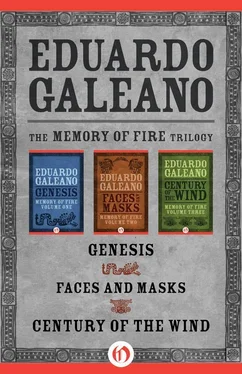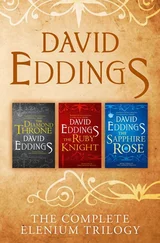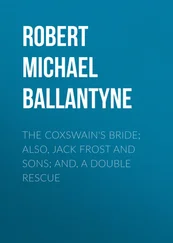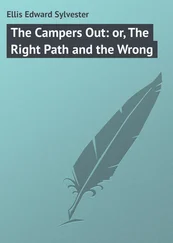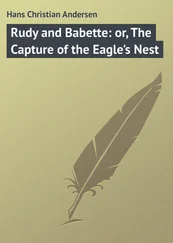DIRECT IMPORTATION
The taste would not be too-too, but it was nearly-nearly, and no one got stomach ulcers. The business went like a house on fire. The factory could not keep up with the demand, but Don Vicente came down with an attack of patriotism and decided he could not go on living in a state of treason.
“This good reputation belongs only to Chile.”
He threw the European labels in the fire and had another sign put on his door, this time even larger:
NATIONAL INDUSTRY
The bottles now wear a new dress: labels printed here, which say in Spanish: Chilean Cognac.
Not even one can be sold.
(256)
Street Cries in the Santiago de Chile Market
“Carnations and basil for stocky little girls!”
“WA-A-FER COOKIES!”
“Pretty buttons, one penny the string!”
“Sulphur matche-e-es!”
“Belts, cinches, soft like a glove!”
“Charity, for the love of God!”
“Good beef!”
“A penny for a poor blind man?”
“BROO-OO-OMS! LAST CHANCE FOR BROOMS!”
“Baccy, chewing baccy?”
“Miraclemedals, single or by the box!”
“Look at these brandy cakes!”
“Knives f’yer personal security!”
“SHA-A-ARP BLADES!”
“Who’ll buy this rope?”
“Get this lovely bread!”
“Little bells, only one left!”
“WATERMELONS, DEARIE!”
“Get this lovely bread, fresh from a woman’s hands!”
“WA-A-ATERMELONS!”
“Get this lovely bread! It’s piping hot!”
(288)
Llamas
“Happy creatures,” says Flora Tristán.
Flora is travelling through Peru, her father’s country, and in the mountains discovers the only animal man has not been able to debase.
The gentle llamas are more agile than mules and climb higher. They resist cold, exhaustion, and heavy loads. With no reward they give the mountain Indians transport, milk, meat, and the clean and brilliant wool that covers their bodies. But they never let themselves be tied up or mistreated, nor do they take orders. When they let up their queenly stride, the Indian implores them to get going again. If anyone hits them, insults them, or threatens them, llamas throw themselves on the ground, and, raising their long necks, they turn their eyes heavenward, the most beautiful eyes in Creation, and softly die.
“Happy creatures,” says Flora Tristán.
(337)
Aquino
The head of Aquino lies in the executioner’s basket.
May he rest in war. The chief of the Indians of El Salvador had raised three thousand spears against the robbers of lands. He got the better of the muskets, which the enemy fired with glowing cigars, and stripped Saint Joseph naked on the high altar of a church. Clad in the cloak of the father of Christ, he proclaimed that Indians would never again be slaves, nor soldiers, nor famished, nor drunk. But more troops arrived, and he had to seek refuge in the mountains.
His lieutenant, named Cascabel, turned him in.
“Now I am a jaguar without claws or fangs,” said Aquino, when they loaded him with shackles and chains; and he confessed to Fray Navarro that in all his life he had only been frightened by the anger or tears of his wife.
“ I am ready to play blindman’s buff ,” he said, when they put on the blindfold.
(87)
Tacuabé
On the headlands of the Quequay, General Rivera’s cavalry have completed the civilizing operation with good marksmanship. Now, not an Indian remains alive in Uruguay.
The government donates the four last Charrúa Indians to the Natural Sciences Academy in Paris. They are sent over in the hold of a ship, as baggage, among other packages and valises.
The French public pay admission to see the savages, rare specimens of a vanished race. The scientists note their gestures, clothing, and anthropometric measurements. From the shape of their skulls, they deduce their small intelligence and violent character.
Before two months have passed, the Indians let themselves die. Academicians fight over the cadavers. Only the warrior Tacuabé survives, and escapes with his newly born daughter, reaching the city of Lyons — who knows how — disappearing there.
Tacuabé was the one who made music. He made it in the museum after the public left. He would rub a bow with a little saliva-moistened stick and draw sweet vibrations from its horsehair strings. Frenchmen who spied on him from behind the curtains said he produced very soft, muffled, almost inaudible sounds, as if he were talking in secret.
(19)
Loving Is Giving
A calabash filled with vinegar mounts guard behind each door. On every altar a thousand candles pray. Doctors prescribe bloodlettings and chloride fumigations. Colored flags mark houses invaded by the plague. Lugubrious chants and cries indicate the passage of carts full of the dead through streets with nobody on them.
The governor issues a proclamation banning certain foods. According to him, stuffed chilis and fruits have brought cholera to Mexico.
On Holy Ghost Street, a coachman is cutting an enormous chirimoya. He stretches out from his perch to enjoy eating it bit by bit. Someone passing by leaves him with his mouth open.
“Barbarian! Don’t you see you’re committing suicide? Don’t you know that that fruit takes you to the grave?”
The coachman hesitates. He contemplates the milky flesh, undecided whether to bite. Finally he gets up, walks a few steps and offers the chirimoya to his wife, who is sitting at the corner.
“You eat it, my love.”
(266)
Darwin
Black hills rise from the sea and mist. On the rocks, as if taking siestas, move turtles as big as cows; and between the crannies slide iguanas, dragons without wings.
“The capital of hell,” comments the captain of the Beagle.
“Even the trees feel bad,” Charles Darwin confirms, as the anchor falls.
In these islands, the Galapagos, Darwin approaches the revelation of the mystery of mysteries. Here, he senses the keys to the never-ending transformation of life on earth. He discovers here how chaffinches have perfected their beaks; how the beak that breaks big hard seeds has taken on the form of a nutcracker, and the one that seeks nectar from cactuses that of a pincers. The same has occurred, Darwin discovers, with the shells and necks of turtles, according to whether they eat on ground level or prefer lofty fruits.
In the Galapagos is the origin of all my opinions, Darwin will write. I go from surprise to surprise, he writes now, in his travel journal.
When the Beagle sailed four years ago from an English port, Darwin still believed every word of the Sacred Writings. He thought God had made the world the way it is now, in six days, and had ended his work, as Archbishop Usher insists, at 9 A.M. on Saturday October 12 of the year 4004 before Christ.
(4 and 88)
Texas
Fifteen years ago, a wagon train creaked across the desert prairie of Texas, and the mournful voices of owls and coyotes bid them illcome. Mexico ceded lands to these three hundred families that came from Louisiana with their slaves and plows. Five years ago, there were already twenty thousand North American colonists in Texas, and they had many slaves purchased in Cuba or in the corrals where the gentry of Virginia and Kentucky fatten up little blacks. Now, the colonists hoist their own flag, the image of a bear, and decline to pay taxes to the government of Mexico or to obey Mexican law which has abolished slavery in all the national territory.
Читать дальше
